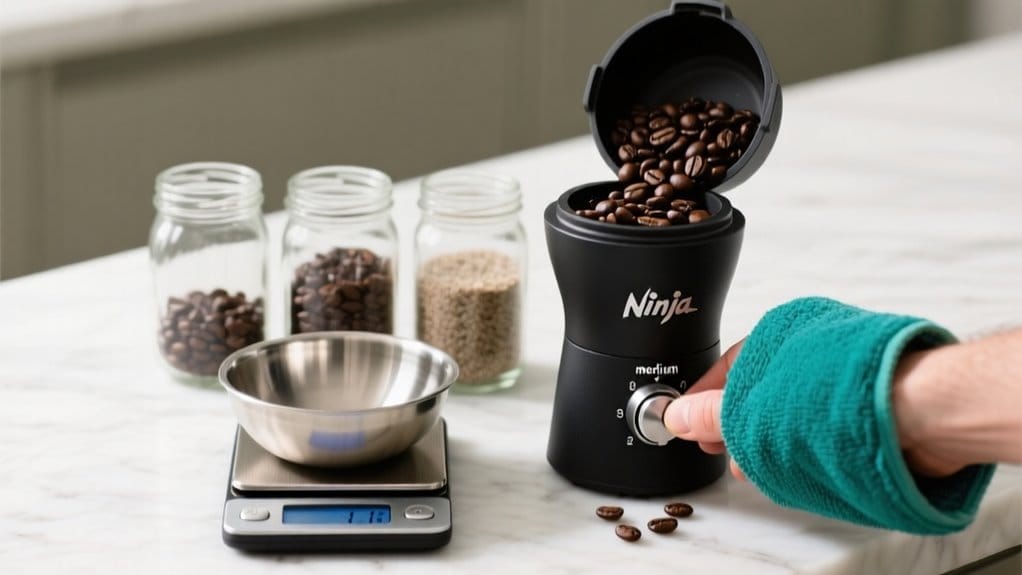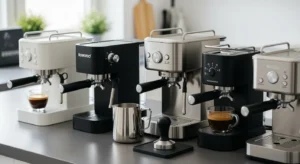To grind coffee perfectly with a Ninja grinder, select the appropriate grind size for your brewing method—fine for espresso, medium for drip, or coarse for French press. The Pro models with conical burr grinders offer superior consistency through weight-based dosing. Use short pulses for coarser grinds to prevent overheating, and clean regularly to avoid oil buildup. Experimenting with different ratios (like 1:2 for espresso or 1:15 for drip) reveals flavor profiles you never knew existed!
Key Takeaways
- Select the appropriate grind setting: powder-fine for espresso, medium for drip coffee, and chunky-coarse for French press.
- Maintain proper bean-to-water ratios: 1:2 for espresso, 1:15-1:17 for drip coffee, and 1:12-1:15 for French press.
- Use short pulses when grinding coarse coffee to prevent overheating and preserve flavor.
- Clean your grinder regularly by brushing accessible burr parts to prevent coffee oil buildup.
- Experiment with different grind settings to customize your coffee’s flavor profile to your preferences.
Selecting the Right Ninja Model for Coffee Grinding
When did choosing a coffee grinder get so complicated? It’s like you need a PhD in “Coffeeology” just to pick between Ninja models!
The Luxe Café Pro offers that fancy 4-in-1 versatility with espresso capabilities, while the Premier Series cuts back to 3-in-1 functionality (still impressive, right?). For model comparisons, focus on your brewing preferences—espresso lovers should splurge on the Pro with its tamping lever and 13 espresso styles!
Space-strapped kitchens? The CM401/CM407 models are more compact but—plot twist—they don’t actually have built-in grinders! The Pro version is slightly bulkier than the standard model, measuring half an inch taller and deeper.
The Luxe models feature those superior conical burr grinders with weight-based dosing that’ll make your coffee nerd friends jealous.
Bottom line: bigger budget, bigger appliance, better grind consistency!
Optimal Bean-to-Blade Ratios for Different Brew Methods
The secret to coffee grinding nirvana isn’t just pushing buttons randomly—it’s all about that perfect bean-to-blade ratio! Your Ninja appliance can tackle any brew method when you know the right proportions.
| Brew Method | Bean-to-Water Ratio | Grind Setting |
|---|---|---|
| Espresso ratios | 1:2 (20g:40g) | Fine, pulsed |
| Drip ratios | 1:15 to 1:17 | Medium, 400-600W |
| French press ratios | 1:12 to 1:15 | Coarse pulses |
| Pour over ratios | 1:15 to 1:17 | Medium-fine |
As you perfect your grind, remember that the Coffee Bean Belt is crucial for maintaining diverse flavor profiles influenced by regional growing conditions. Additionally, the grind size consistency is essential for optimizing caffeine extraction and enhancing flavor in your final brew.
Step-by-Step Grinding Techniques for Various Grind Sizes

Mastering your Ninja appliance for the perfect coffee grind isn’t rocket science, but it does require some know-how!
Initially, locate that grind selector near the bean hopper and familiarize yourself with the range—from powder-fine for espresso to chunky-coarse for French press. Trust me, experimenting with settings makes all the difference!
Finding your perfect grind setting is like discovering coffee’s secret code—start exploring and your taste buds will thank you!
For espresso, aim for that fine-salt texture (about 20 grams per 8 oz shot). Drip coffee? Go medium, like granulated sugar. And if you’re into French press or cold brew styles, crank it to coarse—think sea salt chunks!
The secret? Short pulses prevent overheating, and always adjust in tiny increments between batches.
Oh, and clean that grinder thoroughly after each use—nobody wants yesterday’s dark roast mingling with today’s breakfast blend!
Cleaning and Maintaining Your Ninja After Coffee Grinding
Keeping your Ninja appliance spotless after grinding coffee beans isn’t just about aesthetics—it’s essential for maintaining flavor quality and extending the machine’s lifespan!
Daily maintenance couldn’t be simpler—just empty that drip tray completely (trust me, forgotten coffee sediment is nobody’s friend!), and hand wash the portafilter and basket with warm soapy water.
Oh, and don’t forget to brush those accessible burr parts—coffee oils build up faster than you’d think!
For weekly cleaning tips, run that automated cleaning cycle when the “clean” light starts giving you the stink eye.
Pop in the cleaning disc with a tablet, and let the six-minute backflush work its magic!
And please, please use filtered water—your taste buds and machine internals will thank you with delicious coffee for years to come!
Frequently Asked Questions
Can I Grind Other Spices in My Ninja After Grinding Coffee?
While coffee beans dance with cinnamon sticks, yes, one can utilize the Ninja for spice grinding after coffee. However, thorough cleaning is essential to prevent flavor absorption between uses.
How Long Do Coffee Beans Stay Fresh After Grinding?
Ground coffee’s ideal freshness duration is 15-30 minutes post-grinding, when flavor compounds are most vibrant. Proper grinding techniques and airtight storage can extend acceptable quality for up to one week.
Will Grinding Coffee Void My Ninja Warranty?
Grinding coffee alone won’t void Ninja’s warranty coverage, unlike unauthorized modifications. Normal use of appropriate compartments remains protected, though users should observe appliance limitations and maintain cleanliness to preserve warranty eligibility.
Can I Use Pre-Roasted Grocery Store Coffee Beans?
Yes, Ninja appliances accommodate pre-roasted grocery store coffee beans. While not offering the same pre-ground quality as freshly roasted options, most bean varieties from supermarkets will work effectively with Ninja’s grind settings.
How Does Ninja’s Grind Compare to Dedicated Coffee Grinders?
Ninja’s conical burr grinder offers good grind consistency across 25 settings, though dedicated grinders typically provide superior particle uniformity and precise adjustments that enhance flavor extraction, especially for specialty espresso preparation.
References
- https://www.ninjakitchen.com/page/espresso-machines
- https://www.ninjakitchen.com/products/ninja-luxe-cafe-premier-3-in-1-espresso-drip-coffee-cold-brew-maker-zidES601
- https://www.ninjakitchen.com/page/coffee-tea-makers
- https://support.ninjakitchen.com/hc/en-us/articles/19455493529244-ES700-Series-Ninja-Luxe-Café-Pro-Series-FAQs
- https://www.coffeeforums.com/threads/grind-coffee-beans.19935/
- https://www.youtube.com/watch?v=unHHToGjshI



